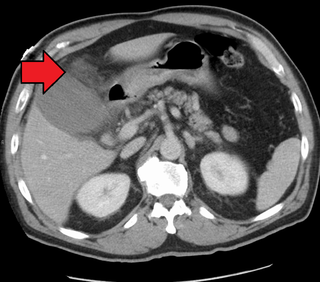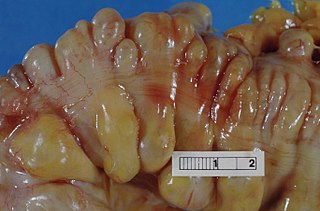
Cholecystitis is inflammation of the gallbladder. Symptoms include right upper abdominal pain, nausea, vomiting, and occasionally fever. Often gallbladder attacks precede acute cholecystitis. The pain lasts longer in cholecystitis than in a typical gallbladder attack. Without appropriate treatment, recurrent episodes of cholecystitis are common. Complications of acute cholecystitis include gallstone pancreatitis, common bile duct stones, or inflammation of the common bile duct.

Diverticulitis, specifically colonic diverticulitis, is a gastrointestinal disease characterized by inflammation of abnormal pouches—diverticula—which can develop in the wall of the large intestine. Symptoms typically include lower abdominal pain of sudden onset, but onset may also occur over a few days. There may also be nausea; and diarrhea or constipation. Fever or blood in the stool suggests a complication. Repeated attacks may occur.

Gastritis is inflammation of the lining of the stomach. It may occur as a short episode or may be of a long duration. There may be no symptoms but, when symptoms are present, the most common is upper abdominal pain. Other possible symptoms include nausea and vomiting, bloating, loss of appetite and heartburn. Complications may include stomach bleeding, stomach ulcers, and stomach tumors. When due to autoimmune problems, low red blood cells due to not enough vitamin B12 may occur, a condition known as pernicious anemia.

Gastrointestinal diseases refer to diseases involving the gastrointestinal tract, namely the oesophagus, stomach, small intestine, large intestine and rectum, and the accessory organs of digestion, the liver, gallbladder, and pancreas.
This is a shortened version of the sixth chapter of the ICD-10: Diseases of the nervous system. It covers ICD codes G00.0 to G99. All versions of the ICD-10, including the most recent one (2019), can be browsed freely on the website of the World Health Organisation (WHO). The ICD-10 can also be downloaded in PDF-form.
This is a shortened version of the ninth chapter of the ICD-10: Diseases of the circulatory system. It covers ICD codes I00 to I99. All versions of the ICD-10, including the most recent one (2019), can be browsed freely on the website of the World Health Organisation (WHO). The ICD-10 can also be downloaded in PDF-form.
This is a shortened version of the tenth chapter of the ICD-10: Diseases of the respiratory system. It covers ICD codes J00 to J99. All versions of the ICD-10, including the most recent one (2019), can be browsed freely on the website of the World Health Organisation (WHO). The ICD-10 can also be downloaded in PDF-form.
This is a shortened version of the thirteenth chapter of the ICD-10: Diseases of the musculoskeletal system and connective tissue. It covers ICD codes M00.0 to M99. All versions of the ICD-10, including the most recent one (2019), can be browsed freely on the website of the World Health Organisation (WHO). The ICD-10 can also be downloaded in PDF-form.
This is a shortened version of the fourteenth chapter of the ICD-10: Diseases of the genitourinary system. It covers ICD codes N00.0 to N99.9. All versions of the ICD-10, including the most recent one (2019), can be browsed freely on the website of the World Health Organisation (WHO). The ICD-10 can also be downloaded in PDF-form.
This is a shortened version of the seventeenth chapter of the ICD-10: Congenital malformations, deformations and chromosomal abnormalities. It covers ICD codes Q00.0 to Q99.9. All versions of the ICD-10, including the most recent one (2019), can be browsed freely on the website of the World Health Organisation (WHO). The ICD-10 can also be downloaded in PDF-form.
This is a shortened version of the first chapter of the ICD-10: Certain infectious and parasitic diseases. It covers ICD codes A00 to B99. All versions of the ICD-10, including the most recent one (2019), can be browsed freely on the website of the World Health Organisation (WHO). The ICD-10 can also be downloaded in PDF-form.

The abdominopelvic cavity is a body cavity that consists of the abdominal cavity and the pelvic cavity. It contains the stomach, liver, pancreas, spleen, gallbladder, kidneys, and most of the small and large intestines. It also contains the urinary bladder and internal reproductive organs. The abdominal pelvic cavity is a little pocket sac that lies way low in the base of the abdominal pelvis cavity. There's no membrane that separates out the abdominal cavity from the pelvic cavity so it is sometimes referred to as the abdominal pelvis or the peritoneal cavity. There are many diseases and disorders associated with the organs of the abdominopelvic cavity.
This is a shortened version of the second chapter of the ICD-10: Neoplasms. It covers ICD codes C00.0 to D48.9. All versions of the ICD-10, including the most recent one (2019), can be browsed freely on the website of the World Health Organisation (WHO). The ICD-10 can also be downloaded in PDF-form.
This is the first chapter of the ICD-11 MMS: Certain infectious or parasitic diseases. It covers ICD codes 1A00 to 1H0Z. The entities listed here are from the most recent revision of the ICD-11 MMS: version 04/2019. The full chapter can be browsed freely on the ICD-11 Browser of the website of the World Health Organization.